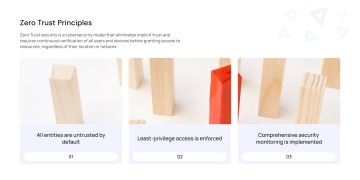Zero Trust Security for NIS2 Compliance: A Detailed Look Inside

The EU's Network and Information Security Directive (NIS2) mandates that a wide range of organizations adopt Zero Trust security principles. This shift reflects the limitations of traditional perimeter-based security models in the face of increasing cyber threats and evolving work environments.
What is Zero Trust Security?
Zero Trust is a departure from traditional "castle-and-moat" security models that focused on securing the network perimeter while implicitly trusting those within. With the rise of cloud computing, remote work, and increasingly sophisticated cyber threats, the perimeter has become blurred, making Zero Trust an essential approach to modern network security.
In essence, Zero Trust security eliminates the concept of implicit trust, requiring continuous verification and validation for every access attempt. It enables organizations to better protect their sensitive data and assets in an increasingly complex and dynamic threat landscape.
Why NIS2 Mandates Zero Trust
NIS2 expands the scope of organizations subject to cybersecurity regulations, encompassing sectors like food production, postal services, manufacturing, and digital providers. A core requirement is the implementation of Zero Trust, a security model that eliminates implicit trust and continuously verifies users and devices before granting access to resources.
Core Principles of Zero Trust
Strict Identity Verification: Every user and device attempting to access network resources must undergo strict identity verification, regardless of their location. This involves multi-factor authentication and continuous validation of user and device credentials.
Least-Privilege Access: Users and devices are granted only the minimum level of access needed to perform their tasks.
Continuous Monitoring: Trustworthiness is constantly re-evaluated, and access can be revoked if suspicious activity is detected.
Role-Based Access Control: Access is dynamically determined based on a user's or device's role and context.
Microsegmentation: The network is divided into smaller segments to contain the impact of a breach, preventing lateral movement across the network.
Benefits of Zero Trust for NIS2 Compliance
Zero Trust, a modern security approach, offers significant benefits over traditional security models:
1. Reduced Attack Surface:
By implementing Zero Trust principles, organizations can limit access to resources based on the principle of least privilege. This means that users are only granted the minimum level of access necessary to perform their job functions. This approach reduces the attack surface and makes it more difficult for attackers to move laterally within the network.
Additionally, continuous monitoring of user activity allows for the detection of anomalous behavior and potential threats. This can help organizations to quickly identify and respond to security breaches. As a result, implementing Zero Trust principles can help organizations to improve their security posture and reduce the risk of data breaches.
2. Improved Visibility:
Zero Trust provides organizations with a comprehensive view of network activity and potential vulnerabilities. By collecting and analyzing data from various sources, organizations can gain deeper insights into user behavior, network traffic, and system configurations. This improved visibility enables security teams to identify and remediate threats more effectively.
3. Enhanced Security Posture:
Zero Trust aligns with the requirements of the Network and Information Security (NIS2) Directive, which sets out stringent cybersecurity measures for organizations operating within the European Union. By adopting Zero Trust principles, organizations can demonstrate their commitment to cybersecurity best practices and enhance their overall security posture. Compliance with NIS2 requirements can also help organizations build trust with customers, partners, and regulators.
4. Simplified Security Management:
Zero Trust eliminates the need for complex network segmentation and firewall configurations by focusing on access control and continuous monitoring. This approach allows organizations to simplify their security infrastructure and reduce operational costs.
5. Improved User Experience:
Zero Trust enables organizations to provide users with seamless and secure access to resources, irrespective of their location or device, which can improve productivity and employee satisfaction.
6. Scalability and Agility:
Zero Trust is a flexible and agile security model that can adapt effortlessly to changes in the IT environment. Organizations can promptly add or remove users, devices, and applications without compromising the security of their systems.
Assessing Your Zero Trust Readiness
Implementing Zero Trust is often hindered by the complexity of achieving least-privilege access and continuous monitoring. A Ponemon Institute study reveals that nearly half of organizations haven't adopted Zero Trust, with many citing the lack of integration between disparate access control tools as a major obstacle.
With the NIS2 compliance deadline approaching, organizations should evaluate their current security posture. Key questions to consider include:
Do you have complete visibility into all devices on your network?
Can you consistently assign privileges and enforce security policies?
Are you able to continuously monitor the security state of users and devices?
Conclusion
Zero Trust is a critical component of NIS2 compliance. By adopting this security model, organizations can strengthen their defenses, reduce the risk of cyberattacks, and demonstrate their commitment to protecting sensitive data and critical infrastructure.